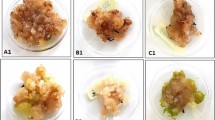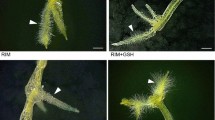Abstract
Biological activity of the extract from golden root (Rhodiola rosea L.) roots, containing the complex of phenylpropanoids (CPP), was studied on the cell culture of yam (Dioscorea deltoidea Wall) under normal conditions and abiotic stress. The high radical-binding capacity of CPP relative to anion- and hydroxyl-radicals was observed. Having a high level of antiradical protection, CPP at a high concentration(100 μM) exerted prooxidant effect, causing a decrease in D. deltoidea cell viability and a decrease in the activities of antioxidant enzymes: superoxide dismutase, guaiacol-dependent peroxidase, and catalase, with the exception of ascorbate peroxidase. At treatment with 100 μM CPP, oxidase (prooxidant) activity of peroxidase increased by three times. The low CPP concentration (2 μM) did not induce substantial changes in the activities of tested enzymes and also a substantial increase in the oxidase activity of peroxidase. Under conditions of oxidative stress induced by paraquat and high temperature, CPP manifested adaptogenic action, increasing cell viability; however, under hyperosmotic stress, it was not efficient. CPP was most efficient at a low concentration after cell pre-incubation with it for 5 days. In this case, the amount of primary and secondary POL products increased. Shortening pre-cultivation with CPP reduced its defensive effect.
Similar content being viewed by others
Abbreviations
- APO:
-
ascorbate peroxidase
- ARA:
-
antiradical activity
- CAT:
-
catalase
- CD:
-
conjugated dienes
- CPP:
-
complex of phenylpropanoids
- PO:
-
guaiacol-dependent peroxidase
- SOD:
-
superoxide dismutase
- TBARS:
-
thiobarbituric acid-reacting substances
References
Foyer, C.H. and Noctor, G., Oxidant and Antioxidant Signaling in Plants: A Re-Evaluation of the Concept of Oxidative Stress in a Physiological Context, Plant Cell Environ., 2005, vol. 28, pp. 1056–1071.
Mittler, R., Oxidative Stress, Antioxidants and Stress Tolerance, Trends Plant Sci., 2002, vol. 7, pp. 405–410.
Jones, D.P., Radical-Free Biology of Oxidative Stress, Am. J. Physiol. Cell Physiol., 2008, vol. 295, pp. 849–868.
Zenkov, N.K., Kandalintseva, N.V., Lankin, V.Z., Men’shchikova, E.B., and Prosenko, A.E., Fenol’nye bioantioksidanty (Phenolic Antioxidants), Novosibirsk: Sib. Otd. Russ. Acad. Med. Sci., 2003.
Halliwell, B., Are Polyphenols Antioxidants or Pro-Oxidants? What Do We Learn from Cell Culture and In Vivo Studies, Arch. Biochem. Biophys., 2008, vol. 476, pp. 107–112.
Kurkin, V.A., Phenylpropanoids in Therapeutic Plants: Their Distribution, Classification, Structural Analysis, Biological Activity, Khim. Prir. Soedin., 2003, no. 2, pp. 87–117.
Olenichenko, N.A., Gorodkova, E.S., and Zagoskina, N.V., Effects of Exogenous Phenol Compounds on Lipid Peroxidation in Plants, S.-kh. Biol., 2008, no. 3, pp. 58–61.
Chasov, A.V. and Minibaeva, F.M., Effect of Exogenous Phenols on Superoxide Production by Extracellular Peroxidase from Wheat Seedling Roots, Biochemistry (Moscow), 2009, vol. 74, pp. 766–774.
Staba, E.J., Plant Tissue Culture as a Technique for the Phytochemist, Rec. Adv. Phytochem., 1969, no. 2, pp. 75–106.
Volkova, L.A., Urmantseva, V.V., Burgutin, A.B., Maevskaya, S.N., and Nosov, A.M., Stimulation of Defense Responses of In Vitro Potato Plants by Treatment with Steroid Glycosides under Abiotic Stresses, Russ. J. Plant Physiol., 2011, vol. 58, pp. 928–935.
Chung, S.-K. and Osawa, T., Hydroxy Radical Scavengers from White Mustard (Sinapis alba), Food Sci. Biotechnol., 1998, vol. 7, pp. 209–213.
Beauchamp, C. and Fridovich, J., Superoxide Dismutase: Improved Assays and an Assay Applicable to Acrylamide Gels, Anal. Biochem., 1971, vol. 44, pp. 276–287.
Yarosh, N.P., Arasimovich, V.V., Ermakov, A.I., and Peruanskii, Yu.V., Determination of Enzymes and Their Inhibitor Activity, Metody biokhimicheskogo issledovaniya rastenii (Methods for Biochemical Investigation of Plants), Ermakov, A.I., Ed., Leningrad: Agropromizdat, 1987, pp. 41–43.
Gerbling, K.P., Kelly, G.J., Fischer, K.H., and Latzko, E., Partial Purification and Properties of Soluble Ascorbate Peroxidases from Pea Leaves, J. Plant Physiol., 1984, vol. 115, pp. 59–67.
Aebi, H., Catalases, Methods Enzym. Analysis, 1971, vol. 3, pp. 273–286.
Stal’naya, I.D., Method for Determination of Dienoic Conjugation of Unsaturated Higher Fatty Acids, Sovremennye metody v biokhimii (Modern Methods in Biochemistry), Orekhovich, V.N., Ed., Moscow: Meditsina, 1977, pp. 63–64.
Heath, R.L. and Packer, L., Photoperoxidation in Isolated Chloroplasts. 1. Kinetics and Stoichiometry of Fatty Acid Peroxidation, Arch. Biochem. Biophys., 1969, vol. 125, pp. 189–198.
Samygin, G.A., Volkova, L.A., and Popov, A.S., Comparing of Different Methods for the Assessment of Cell Viability in Suspension and Callus Cultures, Sov. Plant Physiol., 1985, vol. 32, pp. 813–817.
Fini, A., Brunetti, C., di Ferdinando, M., Ferrini, F., and Tattini, M., Stress-Induced Flavonoid Biosynthesis and the Antioxidant Machinery of Plants, Plant Signal. Behav., 2011, vol. 6, pp. 709–711.
Zhao, H.J. and Zou, Q., Protective Effect of Exogenous Antioxidants and Phenolic Compounds on Photosynthesis of Wheat Leaves under High Irradiance and Oxidative Stress, Photosynthetica, 2002, vol. 40, pp. 523–527.
Zhang, J., Stanley, R.A., Adaim, A., Melton, D.L., and Skinner, A.M., Free Radical Scavenging and Cytoprotective Activities of Phenolic Antioxidants, Mol. Nutr. Food Res., 2006, vol. 50, p. 996–1005.
Voeikov, V.L., Beneficial Role of Active Oxygen Species, Biochemistry (Moscow), 2004, vol. 69, pp. 24–38.
Tarchevsky, I.A., Regulatory Role of Biopolymer and Lipid Degradation, Sov. Plant Physiol., 1992, vol. 39, pp. 815–820.
Williams, R.J., Spencer, J.P., and Rice-Evans, C., Flavonoids: Antioxidants or Signalling Molecules? Free Radic. Biol. Med., 2004, vol. 36, pp. 838–849.
Andreev, I.M., Role of Mechanical Properties of Membranes in Dynamics of the Behavior of Membrane Systems in Plant Cells, Russ. Plant Physiol., 1993, vol. 40, pp. 430–437.
Das, D.K. and Maulik, N., Conversion of Death Signal into Survival Signal by Redox Signaling, Biochemistry (Moscow), 2004, vol. 69, pp. 10–17.
Karpets, Yu.V. and Kolupaev, Yu.E., Role of Oxidative Stress in Induction of Wheat Seedling Heat-Resistance at Short-Term Treatment with Sublethal Temperature, Fiziol. Biokh. Kul’t. Rast., 2008, vol. 40, pp. 245–252.
Arora, A., Byrem, T.M., Nair, M.G., and Strasburg, G.M., Modulation of Liposomal Membrane Fluidity by Flavonoids and Isoflavonoids, Arch. Biochem. Biophys., 2000, vol. 373, pp. 102–109.
Los, D.A., Molecular Mechanisms of Plant Cold Tolerance, Vestn. Ross. Akad. Nauk, 2005, vol. 75, pp. 338–345.
Author information
Authors and Affiliations
Corresponding author
Additional information
Original Russian Text © L.A. Volkova, V.V. Urmantseva, A.B. Burgutin, A.M. Nosov, 2013, published in Fiziologiya Rastenii, 2013, Vol. 60, No. 2, pp. 230–239.
Rights and permissions
About this article
Cite this article
Volkova, L.A., Urmantseva, V.V., Burgutin, A.B. et al. Adaptogenic action of the complex of phenylpropanoids on Dioscorea deltoidea cell culture under abiotic stress. Russ J Plant Physiol 60, 235–243 (2013). https://doi.org/10.1134/S102144371301010X
Received:
Published:
Issue Date:
DOI: https://doi.org/10.1134/S102144371301010X




